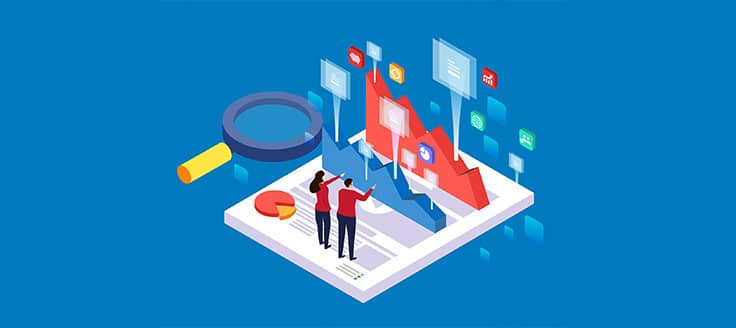There’s no doubt about it: small businesses power the U.S.
They make up 99.9% of U.S. businesses, according to the Small Business Administration (SBA).
Most are “solopreneur ships.” According to data from the U.S. Census Bureau, more than 75% of small businesses were nonemployees or had no employees.
Others drive job growth throughout the U.S. In 2019, small businesses created 1.8 million new jobs.
Small businesses are vital to American life for many reasons. They produce innovative products and services. They provide diverse employment. And they contribute to communities.
Here are some essential small business in America statistics that provide a glimpse into the future of small business growth and lending trends.
Small Business Growth Statistics
1. About 4 Out of 5 Small Businesses Will Survive a Year or More
The SBA reports 79.8% of businesses that opened in 2016 survived until 2017. More promising growth statistics include:
- About half of all small businesses will survive 5 years or longer
- About 1/3 of small businesses will last 10 years or longer
The survival rate is increasing. Between 2005-2017, 78.6% of businesses survived 1 year. An increase in survival rate is promising for up-and-coming entrepreneurs.
2. About 1 in 12 Businesses Closes Every Year – but Not Necessarily Because of Failure
According to a 2018 SBA report, about 1 in 12 closes every year. It’s encouraging that from 1990-2015, the numbers have been trending down.
Low sales are one of the top 3 reasons for business closures, but sales-related closures only accounted for 25% of business closures in 2015, down from 37.9% in 2007.
The SBA notes many businesses close because of personal reasons, including:
- The owner is retiring
- The owner is selling the business
- The owner is opening another firm
- The business is closing because of health or other reasons
The SBA reports 6.3% of closures were because the owners were opening another business. Serial entrepreneurship is thriving in the U.S., and lenders recognize this.
3. Over 200,000 Businesses Start or Close Every Quarter
Turnover among small businesses in the U.S. can be relatively volatile and swing wildly between total small businesses being gained or lost from one quarter to the next.
Small business startup statistics from the SBA indicate that nearly a quarter of a million businesses start each quarter in the U.S. However, small business failure statistics show that roughly the same number close, so quarterly totals fluctuate between net gains and net losses.
The creation and closure of new businesses also account for significant fluctuation in the job market. With roughly 200,000-300,000 businesses starting or ceasing operations every quarter, this translates into some 700,000-800,000 jobs created and lost every 3 months.

Small Business Employment Statistics
4. About 91% of Small Business Employees Are Optimistic About the Future
It isn’t just small business owners who get satisfaction from working at smaller companies. Small business employees enjoy being able to feel like they directly contribute to their company’s success.
Some notable small business statistics revealed in Aflac’s 2018 Small Business Happiness Survey of 1,000 employees include:
- Nearly two-thirds (65%) of employees say working at a small business is less stressful than working at a large business
- Nearly 9 out of 10 (87%) employees think working at a small business is more fun than working at a large business
- Nearly 9 out of 10 (86%) employees feel like they have opportunities to voice ideas and opinions at work and have them heard and listened to
The survey found the top 3 benefits of working for a small business, and the percentage of employees who named them as the top benefit, are:
- Flexible work schedule: 25%
- Feeling more appreciated: 19%
- Feeling like your input matters: 14%
As to the best part of working for a small business, the top 3 statistics are:
- Feeling like a family: 32%
- Greater ability to make an impact: 14%
- More recognition and appreciation for your work: 14%
Because of factors such as these, 46% of respondents said they felt somewhat optimistic about the future of small business, and 45% said they felt very optimistic about the future. That’s great news for small business owners.
5. Nearly Half of All U.S. Workers are Employed by Small Businesses
Although small businesses account for more than 99% of all business in the U.S., there are some large businesses out there with massive payrolls. Still, according to the SBA, U.S. small businesses employed 59.9 million people, or 47.3% of the private workforce, in 2016.
So, while small businesses may be driving the engine of economic growth, nearly half of American workers are employed by smaller, less stable businesses.
6. Businesses With Under 20 Employees Added the Most Jobs in 2019
The U.S. added a total of about 2.1 million new jobs in 2019. Of those, about 1.2 million were created by businesses with under 20 employees.
In total, small businesses in the U.S. accounted for 1.8 million of the 2.1 million new jobs.
7. Nearly a Quarter of Independent Businesses Plan to Raise Pay in Coming Months
If you don’t already work for a small business, now may be the time to start. According to a survey by the National Federation of Independent Business, 24% of independent business owners plan to raise employee compensation in the coming months.
This is in addition to the 36% of business owners who said they already have increased employee pay.
According to the trade group’s survey, one primary driver for these compensation increases is the difficulty of attracting workers. Small business owners are increasingly having to pay employees more to attract applicants and retain top talent.
8. Health Care, Hotels and Food Service Are the Biggest Job Creators for Small Businesses
According to small business industry statistics from the SBA, the 2 industries with the highest number of small business jobs are:
- Health care and social assistance
- Accommodation and food service
Together, these 2 sectors account for over a quarter of all small business employment.
Other industries with high small business employment include:
- Retail trade
- Manufacturing
- Professional, scientific and technical services
- Construction
Small Business Loan Statistics
9. More than 30% of SBA Financing Supports Minority-Owned Businesses
According to the SBA’s lending statistics, more than 30% of SBA 7(a) and Community Advantage loans go to minority-owned businesses. While these businesses may not be completely minority-owned, these businesses must have at least 51% minority ownership to qualify as minority-owned businesses.
In addition, most SBA lending for small businesses, according to statistics, goes to businesses with 2 or more years in operation. This means that a large portion of the minority-owned businesses with SBA funding are relatively new ventures.
10. The SBA Had Over $1 Billion in Charge-Offs in 2019
The SBA doesn’t lend money directly to small businesses. Instead, loans are issued by lenders and the SBA guarantees a portion of the loans.
After a borrower has defaulted on an SBA loan, they have a period to bring the loan current. However, some of these loans go bad and, when they do, the SBA writes (charges) them off. That process takes the loans off the SBA’s balance sheet once they’re considered worthless.
In total, SBA charge-offs totaled more than $1 billion in 2019. This was up from $808 million in 2018, but is still sharply lower than total charge-offs for 2011, 2012 and 2013 ($2.37 billion, $2.32 billion and $2.05 billion, respectively).
Small Business Revenue Statistics
11. More Than 1 Out of 3 Small Businesses Achieve $150,000 or More in Revenue
A 2018 survey of small business owners by BusinessKnowHow.com found encouraging small business revenue statistics. The site has run the survey for statistics on small business for 5 years since 2007. It found, in 2018, full-time small businesses earned:
- $150,000 to $199,999: 3%
- $200,000 to $499,999: 19%
- $500,000 to $1 million: 4%
- More than $1 million: 9%
12. Incorporated Business Owners Make 2 Times More Than Unincorporated Proprietors
When you set up a small business, it’s a good idea to incorporate your business — as a limited liability company (LLC), limited liability partnership (LLP), S corporation or C corporation, for example. This helps you protect yourself against liability arising from business operations, and can also help you start building business credit.
While not all business owners incorporate their businesses, statistics from the SBA show that those who do incorporate tend to bring in significantly more business revenue than their unincorporated counterparts.
Median income of incorporated small business owners: $49,804
Median income of unincorporated proprietors: $22,424
Minority-Owned Business Statistics
13. 8.7 Million Americans Are Employed by Minority-Owned Small Businesses
Nearly half of Americans are employed by a small business. Of those 59.9 million employees, 8.7 million are employed at a minority-owned business.
14. Immigrants Make Up 18% of U.S. Small Business Owners
According to the U.S. Census, immigrants make up about 13% of the U.S. population. This stands in contrast to the portion of small business owners who are immigrants, which stands at 18%.
These statistics would seem to indicate that immigrants are entrepreneurially-minded. For many, the U.S. really is the land of opportunity.
15. 30% of All U.S. Businesses Are Minority-owned
Throughout the U.S., there are about 8 million minority-owned businesses, according to the SBA. These businesses may not be wholly minority-owned but are owned at least 51% by minorities.
This is a number that has been on the rise, partly because of support from SBA-guaranteed loans.
The Future of Statistics for Businesses Looks Bright
The small business growth statistics we’ve reviewed paint an encouraging picture for current and aspiring small business owners. Small businesses are seeing success and growth, small business owners have small business lending options that work for their unique needs and both small business employees and owners are optimistic about what’s to come.











